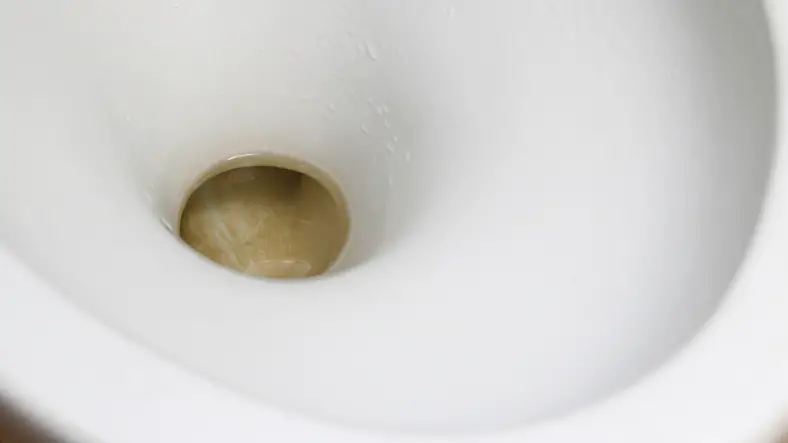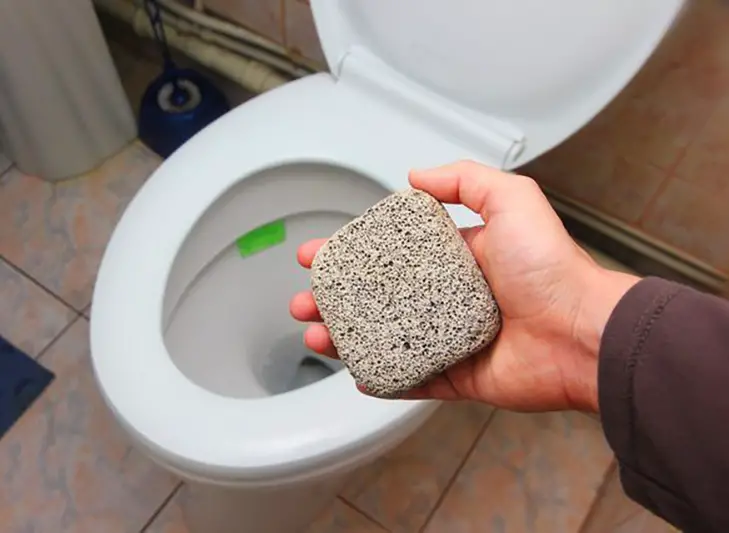Cleaning a toilet bowl can be an exhausting process, especially if it has been unused for an extended period. However, it is a task that has to be done. A dirty toilet bowl harbors harmful bacteria and ugly mineral or soil build-up. Regular cleaning can help eliminate this.
The general toilet cleaning supplies include rubber gloves, bleach, water, disinfectant spray, pumice stone, toilet cleaner solution, toilet brush, vinegar or baking soda, scrub sponge, and paper towels.
Always wear rubber gloves to protect your skin from bacteria and the chemicals in the cleaning agents. You should also be sure to disinfect them after usage. Always check the user instructions before using any toilet cleaners. Some materials require adequate care when mixing with other substances.
Cleaning Steps
- The first step is to flush the toilet and wipe clean the toilet seat. Then apply a toilet cleaner under the toilet seat’s rim and allow it to soak for some time. Add bleach and disinfectant to a bowl of water, use a toilet brush to scrub, and wash down the bowl using the bleach and water solution.
- Clean the toilet’s exterior, wash your way up from the base to the top of the lid. Spray underneath your toilet and the sides thoroughly. Be sure to wash the small area between the toilet seat and the tank and disinfect it, then work your way up the tank and to the top of the tank itself.
- You should also make sure to check inside the tank for brown stains, open the lid and add a cup of vinegar into the water and let it mix well. Flush the toilet to allow the water to rush through the plumbing system into the toilet bowl for a self-wash. Wash the exterior of the tank and disinfect the surface of the toilet. Disinfecting ensures that you eliminate unseen germs from your toilet bowls.

What causes brown stains in a toilet bowl?
Brown stains in the toilet bowl are caused by clogs of minerals compounds and rust in hard water. Rainwater meets with soft rock, like, calcium and other substances, and forms hard water. The high concentration of calcium, lime, iron, and manganese compound in the water at the toilet bowl base reacts to create iron oxide, otherwise known as rust. The lime build-up first forms white clogs, which turn to gray-like color, then green, and finally brown. Rust is the major cause of those brown water stains in your toilet bowl.
Apart from the unpleasant ring formation that the brown stains build mostly at the base of your toilet bowl and under the toilet rim, it is a hiding place for germs and bacteria.
How do I remove brown stains from the toilet bowl?
Brown stains can be cleaned off your toilet seat using various acidic cleaning solutions. You should ensure that you use acidic solutions that are safe for your plumbing pipes.
Brown stains can be removed using soft acidic cleaners, toilet brushes, or even pumice stone.
Removing brown stains using an acidic cleaner
Vinegar has an effective acidic content and can help get rid of the brown stains. Pour two cups of vinegar into the bowl to clear the ring formation at the base. For the stain under the toilet rim, make a paste of vinegar and salt or baking soda, and spread on the stains under the rim and every other part of the bowl.
Leave the paste for about 6 hours and let it dry in. Then wash off with hot water and flush. This process involves very little effort but takes a lot of time. If you are willing to try out a faster method, consider scrubbing off the stains using a toilet brush and an acidic cleaner.
Removing brown stains using a toilet brush
Since the brown stains didn’t form in a day, it may require hard scrubbing to get it off despite using an acidic cleaner. You would need hot water and bleach in addition to the toilet cleaner. Mix the bleach and vinegar in the water, let the solution even out, and then scrub off the brown stains in a repeated fashion until they come off. This process is more strenuous but guarantees a faster result.
Is there a permanent solution to the brown stains?
The permanent solution to your water staining problems and those unpleasant odors is to go directly to the source—your water. Hard water from rain isn’t the best water for you and your family. This water can be treated and made soft by adding white vinegar to your water in the tank; this will help reduce the water’s PH content, which ensures that mineral clogs won’t form in your toilet bowls or waterline rims.
How do you clean a stained toilet bowl?
Toilet stains are not limited to rust and mineral clogs, and cleaning the toilet requires that you understand the stains’ nature and how to clean them.
Other stains in your toilet bowl may include mold, a black ring around the bowl along the waterline, and Serratia marcescens –which causes urinary tract infections. Serratia marcescens is a slimy pink-like substance that dwells around the bowl rim and under the ring. It thrives in damp environments, and the toilet seat makes the perfect habitat.
In addition to the tips on cleaning brown stains, stubborn stains can be removed using cleaning products like baking soda and disinfectants. Try to reduce the water level in the bowl by pumping it away with a toilet brush. Apply the baking soda and then scrub with the toilet brush. Let it sit in for about 30 minutes and flush.

How to clean stained toilet bowl using a pumice stone
While remarkable in its potency, a pumice stone isn’t applicable for cleaning toilets consistently; reserve the task only for irregular deep-cleaning sessions.
You can clean your toilet and polish it up with a pumice stone. Pumice can help you banish stubborn stains from the surface of your toilet. First, ensure that you wipe off the toilet with a paper towel, soak the stone in warm water and gently scrub the stain until it’s gone. Ensure that both the pumice stone and the toilet surface are wet to avoid friction on your toilet surface.
How to clean stubborn stains using toilet bowl cleaner
There are hundreds of toilet cleaning products that can be used to clean stains off your toilets. Several household commodities can be almost as effective and will rid your toilet bowl of the dreaded ring without strong chemicals. Baking soda and vinegar, as explained above, can be viable alternatives for commercial toilet cleaners.
Bleach should not be used as a standalone solution because it merely whitens up the stains and not removes them. You should only use bleach with other toilet cleaning products.
How often should one clean a toilet?
When a bathroom has been neglected for some time, it can encourage a build-up of harmful germs, bacteria, mold, and mildew, which can cause illness, ranging from skin irritation, toilet infections, and urinary tract infections. Due to its humidity, the toilet is a perfect habitat for these harmful bacteria; therefore, keeping your bathroom clean can lead to better hygiene and a range of health benefits.
There is no general rule about how regularly you should clean your toilets as there is no best way to clean toilet surfaces. It is advisable to disinfect your toilet as regularly as possible and give soft cleaning to your toilet every other day. This will ensure that build-ups of lime and rust compounds are broken off early before they turn to stubborn stains.
After cleaning:
- Ensure that all equipment used, especially the ones in direct contact with the toilet bowl, is thoroughly washed and disinfected.
- Soak the toilet brush and scrub sponge in hot water to kill the bacteria that may be stuck in the bristles.
- Leave them to drip dry before storing them in their appropriate holder.

Arthur C. Jackson is the resident handyman and toilet expert for BestToiletGuides.com. Drawing from his experience, he tends to focus on how he can help the consumer.


1 thought on “How to Clean Toilet Bowl – A Step by Step Guide”